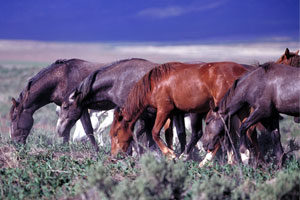“While we have a long way to go, responsible processing represents a vital first step in reversing the unintended consequences to blame for the dismal state of neglected horses and their frustrated caregivers across our country,” said U.S. Rep. Adrian Smith, R-Okla., in a statement. Smith was one of the lawmakers who argued for lifting the de-facto ban. “Reinstating a humane, accountable, and legal management tool is good for horses, good for owners, and is good policy.”
The congressional decision followed a June 2011 report by the Government Accountability Office that criticized the ban and its many unintended consequences. The report said horses exported for slaughter in Canada and Mexico soared, yet prices for those animals dropped. At the same time, animals were subject to less humane standards than those required previously under USDA laws, and in many cases they traveled even farther distances toward slaughter.
Sue Wallis, vice president for United Horsemen, said the GAO report “absolutely turned the tide” in reversing the rationale for the ban supported by animal science.
“The fact was until Congress took the action of having their own research wing look into the situation and document in ascientific way that there was a decline in horse welfare … we didn’t make much sway in talking to members of Congress,” she said. “Once that happened we had a platform to talk about this very necessary change.”
The ban also led to increased cases of animal neglect as large numbers of unwanted horses around the West were abandoned. The GAO report had no comprehensive national data, but state and local authorities saw horse neglect cases skyrocket. State officials in the GAO report attributed the decline in horse welfare to many factors, but primarily to the slaughter ban and the downturn in the U.S. economy.
J.J. Goicoechea, president of the Nevada Cattlemen’s Association, said today’s political climate forced some inflexible members of Congress to listen to cattlemen and western constituents on the issue.
“Some of these policies that have followed the last few years they were not in the best interest of animals and agriculture per se,” he said.
While no figures are available for the volume of neglect cases, Goicoechea, who’s also a vet, said the number of horses he had to euthanize had jumped significantly due to the economy and other factors.
“Due to cost of feed I was being called out more and more,” he said. “That was a huge cost to these people. I know there are individuals that were still buying them for slaughter and exporting them elsewhere, and they were not receiving the most humane treatment.”
The country’s last horse slaughter plants closed doors in 2007. But several states have passed laws or resolutions urging Congress to resume horse slaughter to open paths for more plants.
Wallis said USDA policy requires the agency to provide inspection for amenable species, and since the budget has been signed, a plant could be operational within 90 days.
Goicoechea said that timeline may be too optimistic, since the plants have been out of operation for a few years. “I’d be excited if we could see it within the next six months.” ![]()
PHOTO courtesy of Bureau of Land Management.








